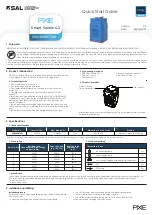
1-6
Based on the network design, you should configure MEPs or the rules for generating MIPs on each
device. However, before doing this you must first configure the service instance.
Configuring Service Instance
A service instance is indicated by an integer to represent an MA in an MD. The MD and MA define the
level and VLAN attribute of the messages handled by the MPs in a service instance.
Follow these steps to configure a service instance:
To do...
Use the command...
Remarks
Enter system view
system-view
—
Enable CFD
cfd enable
Required
CFD is disabled by default.
Create an MD
cfd md
md-name level level-value
Required
Not created by default
Create an MA
cfd ma ma-name md md-name
vlan vlan-id
Required
Not created by default
Create a service instance
cfd service-instance instance-id
md
md-name ma ma-name
Required
Not created by default
z
These configuration tasks are the foundation for other CFD configuration tasks.
z
The last three steps in the table above must be performed strictly in order.
Configuring MEP
MEPs are functional entities in a service instance. CFD is implemented through operations on MEPs,
which provides such functions as CC, LB, LT and gives prompts on error CCMs and cross connections.
As a MEP is configured on a service instance, the MD level and VLAN attribute of the service instance
become the attribute of the MEP.
Follow these steps to configure a MEP:
To do...
Use the command...
Remarks
Enter system view
system-view
—
Enter Ethernet port view
interface interface-type
interface-number
—
Configure a MEP
cfd mep mep-id
service-instance instance-id
{
inbound
|
outbound
}
Required
Not configured by default
















































